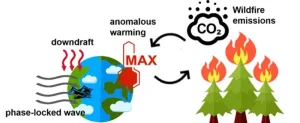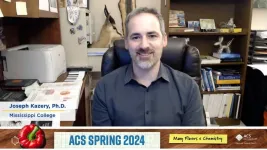(Press-News.org) A team of infectious diseases experts called for more awareness and preparedness in the medical field to deal with the impact of climate change on the spread of diseases. Their article, published today in JAMA raises the alarm about the emergence and spread of harmful pathogens. The authors also urge the medical community to update their education and training and take steps to combat global warming.
“Clinicians need to be ready to deal with the changes in the infectious disease landscape,” said lead author George R. Thompson. Thompson is a professor at the UC Davis School of Medicine in the Department of Internal Medicine, Division of Infectious Diseases, and the Department of Medical Microbiology and Immunology. “Learning about the connection between climate change and disease behavior can help guide diagnoses, treatment and prevention of infectious diseases.”
Thompson encouraged physicians and practitioners to maintain “a high index of suspicion of diseases on the move.” “I think with improvements in our understanding of the disease, there will be more testing and we'll miss fewer cases that way,” he said.
Changing infectious diseases landscape
Infectious diseases can be caused by viruses, bacteria, fungi or parasites. Many of these diseases are transmitted from animal to human or from human to human.
One type of infectious disease is vector-borne diseases. They are caused by pathogens carried by vectors like mosquitoes, fleas and ticks. Some diseases caused by vectors are dengue, malaria and Zika.
Changing rain patterns are expanding vectors’ range and their active periods. Shorter, warmer winters and longer summers are also linked to more vector-borne diseases. For example, diseases caused by ticks (like babesiosis and Lyme disease) are now occurring in the winter too. They’re also being found in regions farther west and north than in the past.
“We're seeing cases of tick-borne diseases in January and February,” said first author of the study Matthew Phillips. Phillips is an infectious diseases fellow at Massachusetts General Hospital and Harvard Medical School. “The tick season is starting earlier and with more active ticks in a wider range. This means that the number of tick bites is going up and with it, the tick-borne diseases.”
Another concern is malaria. The mosquitos that transmit the disease are expanding northward, a climate-induced change. Changing rain patterns have led to more mosquitos and a higher disease transmission rate.
“As an infectious disease clinician, one of the scariest things that happened last summer was the locally acquired cases of malaria. We saw cases in Texas and Florida and then all the way north in Maryland, which was really surprising. They happened to people who didn't travel outside the U.S.,” Phillips said.
Zoonotic diseases, such as plague and hantavirus (carried by rodents), are also showing changes in incidence and location. The experts noted changes in animal migration patterns and natural ranges. Due to their habitat loss, wild animals are coming closer to humans. With that comes a higher risk of animal diseases spilling over to humans and for new pathogens to develop.
The study also pointed to the emergence of new fungal infections, such as Candida auris (C. auris), and changes in the location of some fungal pathogens. For example, the fungal infection Coccidioides (also known as Valley fever) was endemic to hot, dry areas in California and Arizona. But Valley fever was recently diagnosed as far north as Washington State.
Changes in rain patterns and coastal water temperature can also affect the spread of waterborne diseases, such as E. coli and Vibrio. According to the team, the sea level is rising, and storm surges and coastal flooding that used to be rare or extreme events are happening more frequently.
Call for medical community to take steps
Over the last few years, infectious diseases, such as COVID-19, impacted the world enormously.
“They can spring up and cause absolute chaos for the whole world and then we kind of forget about them for a while. Yet, the epidemic and pandemic potential of infections really mandates that we stay involved with federal funding agencies and advisory groups to make sure that infectious diseases don't slip back too far on the public's radar,” Thomspon explained.
The team called for stronger measures for infectious disease surveillance and urged medical educators to train clinicians to anticipate the changes in infectious disease patterns.
“It's not a hopeless situation. There are distinct steps that we can take to prepare for and help deal with these changes. Clinicians see first-hand the impact of climate change on people’s health. As such, they have a role in advocating for policies that can slow climate change,” Phillips said.
Regina C. LaRocque, associate professor of medicine at Harvard Medical School and infectious diseases physician at Harvard Medical School, is a coauthor of this study.
This study was partially supported by National Institutes of Health grants T32AI007061 and 5U19AI166798.
A team of infectious diseases experts called for more awareness and preparedness in the medical field to deal with the impact of climate change on the spread of diseases. Their article, published today in JAMA raises the alarm about the emergence and spread of harmful pathogens. The authors also urge the medical community to update their education and training and take steps to combat global warming.
“Clinicians need to be ready to deal with the changes in the infectious disease landscape,” said lead author George R. Thompson. Thompson is a professor at the UC Davis School of Medicine in the Department of Internal Medicine, Division of Infectious Diseases, and the Department of Medical Microbiology and Immunology. “Learning about the connection between climate change and disease behavior can help guide diagnoses, treatment and prevention of infectious diseases.”
Thompson encouraged physicians and practitioners to maintain “a high index of suspicion of diseases on the move.” “I think with improvements in our understanding of the disease, there will be more testing and we'll miss fewer cases that way,” he said.
Changing infectious diseases landscape
Infectious diseases can be caused by viruses, bacteria, fungi or parasites. Many of these diseases are transmitted from animal to human or from human to human.
One type of infectious disease is vector-borne diseases. They are caused by pathogens carried by vectors like mosquitoes, fleas and ticks. Some diseases caused by vectors are dengue, malaria and Zika.
Changing rain patterns are expanding vectors’ range and their active periods. Shorter, warmer winters and longer summers are also linked to more vector-borne diseases. For example, diseases caused by ticks (like babesiosis and Lyme disease) are now occurring in the winter too. They’re also being found in regions farther west and north than in the past.
“We're seeing cases of tick-borne diseases in January and February,” said first author of the study Matthew Phillips. Phillips is an infectious diseases fellow at Massachusetts General Hospital and Harvard Medical School. “The tick season is starting earlier and with more active ticks in a wider range. This means that the number of tick bites is going up and with it, the tick-borne diseases.”
Another concern is malaria. The mosquitos that transmit the disease are expanding northward, a climate-induced change. Changing rain patterns have led to more mosquitos and a higher disease transmission rate.
“As an infectious disease clinician, one of the scariest things that happened last summer was the locally acquired cases of malaria. We saw cases in Texas and Florida and then all the way north in Maryland, which was really surprising. They happened to people who didn't travel outside the U.S.,” Phillips said.
Zoonotic diseases, such as plague and hantavirus (carried by rodents), are also showing changes in incidence and location. The experts noted changes in animal migration patterns and natural ranges. Due to their habitat loss, wild animals are coming closer to humans. With that comes a higher risk of animal diseases spilling over to humans and for new pathogens to develop.
The study also pointed to the emergence of new fungal infections, such as Candida auris (C. auris), and changes in the location of some fungal pathogens. For example, the fungal infection Coccidioides (also known as Valley fever) was endemic to hot, dry areas in California and Arizona. But Valley fever was recently diagnosed as far north as Washington State.
Changes in rain patterns and coastal water temperature can also affect the spread of waterborne diseases, such as E. coli and Vibrio. According to the team, the sea level is rising, and storm surges and coastal flooding that used to be rare or extreme events are happening more frequently.
Call for medical community to take steps
Over the last few years, infectious diseases, such as COVID-19, impacted the world enormously.
“They can spring up and cause absolute chaos for the whole world and then we kind of forget about them for a while. Yet, the epidemic and pandemic potential of infections really mandates that we stay involved with federal funding agencies and advisory groups to make sure that infectious diseases don't slip back too far on the public's radar,” Thomspon explained.
The team called for stronger measures for infectious disease surveillance and urged medical educators to train clinicians to anticipate the changes in infectious disease patterns.
“It's not a hopeless situation. There are distinct steps that we can take to prepare for and help deal with these changes. Clinicians see first-hand the impact of climate change on people’s health. As such, they have a role in advocating for policies that can slow climate change,” Phillips said.
Regina C. LaRocque, associate professor of medicine at Harvard Medical School and infectious diseases physician at Harvard Medical School, is a coauthor of this study.
This study was partially supported by National Institutes of Health grants T32AI007061 and 5U19AI166798.
END
Experts warn climate change will fuel spread of infectious diseases
2024-03-20
ELSE PRESS RELEASES FROM THIS DATE:
Researchers report on the effectiveness of skin biopsy to detect Parkinson’s and related neurodegenerative diseases
2024-03-20
BOSTON – In a paper published in the Journal of the American Medical Association (JAMA), neurologists at Beth Israel Deaconess Medical Center (BIDMC) showed that a simple skin biopsy test detects an abnormal form of alpha-synuclein, the pathological hallmark of Parkinson’s disease and the subgroup of neurodegenerative disorders known as synucleinopathies, at high positivity rates. Results from this landmark study sponsored by the National Institutes of Health (NIH) validate this cutaneous method as a reliable and convenient tool to help physicians make more accurate diagnoses ...
Treating anxiety, depression in people with heart disease reduced ER visits, hospitalizations
2024-03-20
Research Highlights:
Treating anxiety and depression significantly reduced hospital readmission and emergency room visits in people with heart disease.
This may be the first study to show that treating anxiety and depression with medication or psychotherapy has a significant impact on heart disease outcomes.
People with heart disease who are also diagnosed with anxiety or depression may benefit from mental health treatment to improve cardiovascular outcomes, the study researchers noted.
Embargoed until 4 a.m. CT/5 a.m. ET Wednesday, ...
Manager of Cancer Care Equity Program for NCCN named to ‘40 Under 40’ list from National Minority Quality Forum
2024-03-20
PLYMOUTH MEETING, PA [March 20, 2024] — The National Comprehensive Cancer Network® (NCCN®)—an alliance of leading cancer centers—is pleased to announce that Taneal D. Carter, MS, MPA, has been named one of 2024’s ‘40 Under 40’ by the National Minority Quality Forum (NMQF). Every year, NMQF selects 40 health leaders from minoritized populations under the age of 40 who have been leading the charge to better patient outcomes and build sustainable healthy communities. These 40 leaders have persevered in strengthening their communities and reducing health disparities amid ongoing ...
Free, weekly fresh produce improved diet, physical activity and reduced CVD risk factors
2024-03-20
Research Highlights:
After 16 weeks of free, weekly home delivery of fresh produce, study participants boosted their fruit and vegetable consumption by almost ½ of a serving per day and added 42 minutes to their weekly level of physical activity.
One year later, participants had better blood sugar control and lower bad cholesterol levels compared to adults who did not receive free, weekly produce deliveries.
The study found that adults who participated in the free, weekly produce program had improved cardiovascular health measures.
Embargoed until 8:30 a.m. CT/9:30 a.m. ET, Wednesday, March ...
Electronic waste rising five times faster than documented e-waste recycling: UN
2024-03-20
Geneva / Bonn - The world's generation of electronic waste is rising five times faster than documented e-waste recycling, the UN's fourth Global E-waste Monitor (GEM) reveals today.
The 62 million tonnes of e-waste generated in 2022 would fill 1.55 million 40-tonne trucks, roughly enough trucks to form a bumper-to-bumper line encircling the equator, according to the report from ITU and UNITAR.
Meanwhile, less than one quarter (22.3%) of the year's e-waste mass was documented as having been ...
JAMA Network names new editor in chief of JAMA Network Open
2024-03-20
Chicago, March 20, 2024 – Eli Perencevich, M.D., M.S., has been named the Editor in Chief of JAMA Network Open. Dr. Perencevich is the Associate Chair for Clinical and Health Services Research and Professor of Internal Medicine at the University of Iowa Carver College of Medicine, and the Director of the Center for Access & Delivery Research and Evaluation (CADRE) at the Iowa City VA Medical Center.
With over 20 years of experience studying the epidemiology and outcomes of hospital-acquired infections using mathematical ...
Scientists uncover a causal relationship between remote extreme heat and the Canadian wildfires in 2023
2024-03-20
Wildfires are events that can have significant impacts on ecosystems and human society. In the context of global warming, there has been a notable surge in the frequency and ferocity of wildfires in the Northern Hemisphere over recent years. In 2023, Canada experienced an unprecedented wildfire event, with CO2 emissions increasing by 527.1% over the average of 2001–2022 during the months of May–August. The burned area was more than 6–7 times larger than in a normal year. Notably, both Canada and more than 15 states in the northeastern ...
Crawfish could transfer ionic lithium from their environment into food chain
2024-03-20
NEW ORLEANS, March 20, 2024 — From cell phones to watches to electric cars, lithium-ion rechargeable batteries power a plethora of devices. The increased use of this technology means more lithium could find its way into the environment as consumers discard electronic products. Now, researchers describe how lithium can accumulate in a common Southern crustacean: the crawfish. As the season for catching and eating mudbugs comes into full swing, the researchers’ findings highlight the potential implications for public health and the environment.
The researchers will present ...
Teaching teenagers to understand their feelings is key to life-long resilience, psychologist says
2024-03-20
Helping teenagers to understand what is going on inside their own brains is the key to helping them mature into resilient and independent adults, research suggests.
Sheila Redfern, a consultant clinical child and adolescent psychologist, proposes that rather than focusing on stamping out difficult behaviours, parents should teach teenagers to manage their feelings and relationships in safe ways.
Dr. Redfern says that although parenting teenagers is uniquely challenging, with concerns about social media use, self-harm, ...
Visionary $15 million gift from Wayne & Wendy Holman to NYU Langone Health ensures continued excellence in newly named Holman Division of Endocrinology, Diabetes & Metabolism
2024-03-20
NYU Langone Health has received a $15 million gift from innovators and philanthropists Wayne G. Holman, MD, and Wendy Holman to further elevate the world-class treatment and study of endocrine disorders in the newly named and endowed Holman Division of Endocrinology, Diabetes & Metabolism.
“Wayne and Wendy’s generosity in this important area of medicine will help NYU Langone further enhance our exceptional research, education and clinical care within the Holman Division of Endocrinology, ...





